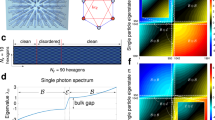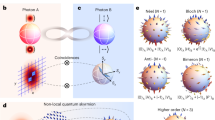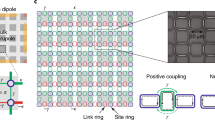Abstract
Entanglement and topology portray nature at the fundamental level but differently. Entangled states of particles are intrinsically sensitive to the environment, whereas the topological phases of matter are naturally robust against environmental perturbations. Harnessing topology to protect entanglement has great potential for reliable quantum applications. Generating topologically protected entanglement, however, remains a significant challenge, requiring the operation of complex quantum devices in extreme conditions. Here we report topologically protected entanglement emitters that emit a topological Einstein–Podolsky–Rosen state and a multiphoton entangled state from a monolithically integrated plug-and-play silicon photonic chip in ambient conditions. The device emulating a photonic anomalous Floquet insulator allows the generation of four-photon topological entangled states at non-trivial edge modes, verified by the observation of a reduced de Broglie wavelength. Remarkably, we show that the Einstein–Podolsky–Rosen entanglement can be topologically protected against artificial structure defects by comparing the state fidelities of 0.968 ± 0.004 and 0.951 ± 0.010 for perfect and defected emitters, respectively. Our topologically protected devices may find applications in quantum computation and in the study of quantum topological physics.
This is a preview of subscription content, access via your institution
Access options
Access Nature and 54 other Nature Portfolio journals
Get Nature+, our best-value online-access subscription
$29.99 / 30 days
cancel any time
Subscribe to this journal
Receive 12 print issues and online access
$209.00 per year
only $17.42 per issue
Buy this article
- Purchase on Springer Link
- Instant access to full article PDF
Prices may be subject to local taxes which are calculated during checkout




Similar content being viewed by others
Data availability
The data that support the plots within this paper and other findings of this study are available from the corresponding authors upon reasonable request.
Code availability
The analysis codes are available from the corresponding authors upon reasonable request.
References
Horodecki, R., Horodecki, P. & Horodecki, M. et al. Quantum entanglement. Rev. Mod. Phys. 81, 865–942 (2009).
Hasan, M. Z. & Kane, C. L. Colloquium: topological insulators. Rev. Mod. Phys. 82, 3045–3067 (2010).
Wang, X.-L., Luo, Y.-H. & Huang, H.-L. et al. 18-qubit entanglement with six photons’ three degrees of freedom. Phys. Rev. Lett. 120, 260502 (2018).
Omran, A., Levine, H. & Keesling, A. et al. Generation and manipulation of Schrödinger cat states in Rydberg atom arrays. Science 365, 570–574 (2019).
Song, C., Xu, K. & Li, H. et al. Generation of multicomponent atomic Schrödinger cat states of up to 20 qubits. Science 365, 574–577 (2019).
Ladd, T. D., Jelezko, F. & Laflamme, R. et al. Quantum computers. Nature 464, 45–53 (2010).
Klitzing, K. V., Dorda, G. & Pepper, M. New method for high-accuracy determination of the fine-structure constant based on quantized Hall resistance. Phys. Rev. Lett. 45, 494–497 (1980).
Haldane, F. D. M. & Raghu, S. Possible realization of directional optical waveguides in photonic crystals with broken time-reversal symmetry. Phys. Rev. Lett. 100, 013904 (2008).
Jotzu, G., Messer, M. & Desbuquois, R. et al. Experimental realization of the topological Haldane model with ultracold fermions. Nature 515, 237–240 (2014).
Poo, Y., Wu, R.-X. & Lin, Z. et al. Experimental realization of self-guiding unidirectional electromagnetic edge states. Phys. Rev. Lett. 106, 093903 (2011).
Segev, M. & Bandres, M. A. Topological photonics: where do we go from here? Nanophotonics 10, 425–434 (2021).
Chen, Z. & Segev, M. Highlighting photonics: looking into the next decade. eLight 1, 2 (2021).
Lu, L., Joannopoulos, J. D. & Soljačić, M. Topological photonics. Nat. Photon. 8, 821–829 (2014).
Ozawa, T., Price, H. M. & Amo, A. et al. Topological photonics. Rev. Mod. Phys. 91, 015006 (2019).
Yuan, L., Dutt, A. & Fan, S. Tutorial: synthetic frequency dimensions in dynamically modulated ring resonators. APL Photon. 6, 071102 (2021).
Wang, Z., Chong, Y. & Joannopoulos, J. D. et al. Observation of unidirectional backscattering-immune topological electromagnetic states. Nature 461, 772–775 (2009).
Kraus, Y. E., Lahini, Y. & Ringel, Z. et al. Topological states and adiabatic pumping in quasicrystals. Phys. Rev. Lett. 109, 106402 (2012).
Hafezi, M., Demler, E. A. & Lukin, M. D. et al. Robust optical delay lines with topological protection. Nat. Phys. 7, 907–912 (2011).
Hafezi, M., Mittal, S. & Fan, J. et al. Imaging topological edge states in silicon photonics. Nat. Photon. 7, 1001–1005 (2013).
Dong, J.-W., Chen, X.-D. & Zhu, H. et al. Valley photonic crystals for control of spin and topology. Nat. Mater. 16, 298–302 (2017).
Kitagawa, T., Broome, M. A. & Fedrizzi, A. et al. Observation of topologically protected bound states in photonic quantum walks. Nat. Commun. 3, 882 (2012).
Xiao, L., Zhan, X. & Bian, Z. H. et al. Observation of topological edge states in parity–time-symmetric quantum walks. Nat. Phys. 13, 1117–1123 (2017).
Rechtsman, M. C., Lumer, Y. & Plotnik, Y. et al. Topological protection of photonic path entanglement. Optica 3, 925–930 (2016).
Wang, Y., Pang, X.-L. & Lu, Y.-H. et al. Topological protection of two-photon quantum correlation on a photonic chip. Optica 6, 955–960 (2019).
Tambasco, J.-L., Corrielli, G. & Chapman, R. J. et al. Quantum interference of topological states of light. Sci. Adv. 4, eaat3187 (2018).
Chen, Y., He, X.-T. & Cheng, Y.-J. et al. Topologically protected valley-dependent quantum photonic circuits. Phys. Rev. Lett. 126, 230503 (2021).
Barik, S., Karasahin, A. & Flower, C. et al. A topological quantum optics interface. Science 359, 666–668 (2018).
Mittal, S., Goldschmidt, E. A. & Hafezi, M. A topological source of quantum light. Nature 561, 502–506 (2018).
Blanco-Redondo, A., Bell, B. & Oren, D. et al. Topological protection of biphoton states. Science 362, 568–571 (2018).
Wang, M., Doyle, C. & Bell, B. et al. Topologically protected entangled photonic states. Nanophotonics 8, 1327–1335 (2019).
Mittal, S., Orre, V. V. & Leykam, D. et al. Photonic anomalous quantum Hall effect. Phys. Rev. Lett. 123, 043201 (2019).
Mittal, S., Orre, V. V. & Goldschmidt, E. A. et al. Tunable quantum interference using a topological source of indistinguishable photon pairs. Nat. Photon. 15, 542–548 (2021).
Wang, J., Sciarrino, F. & Laing, A. et al. Integrated photonic quantum technologies. Nat. Photon. 14, 273–284 (2020).
Elshaari, A. W., Pernice, W. & Srinivasan, K. et al. Hybrid integrated quantum photonic circuits. Nat. Photon. 14, 285–298 (2020).
Llewellyn, D., Ding, Y. & Faruque, I. I. et al. Chip-to-chip quantum teleportation and multi-photon entanglement in silicon. Nat. Phys. 16, 148–153 (2020).
Wang, J., Paesani, S. & Santagati, R. et al. Experimental quantum Hamiltonian learning. Nat. Phys. 13, 551–555 (2017).
Wang, J., Paesani, S. & Ding, Y. et al. Multidimensional quantum entanglement with large-scale integrated optics. Science 360, 285–291 (2018).
Liang, G. Q. & Chong, Y. D. Optical resonator analog of a two-dimensional topological insulator. Phys. Rev. Lett. 110, 203904 (2013).
Pasek, M. & Chong, Y. D. Network models of photonic Floquet topological insulators. Phys. Rev. B 89, 075113 (2014).
Gao, F., Gao, Z. & Shi, X. et al. Probing topological protection using a designer surface plasmon structure. Nat. Commun. 7, 11619 (2016).
Afzal, S., Zimmerling, T. J. & Ren, Y. et al. Realization of anomalous Floquet insulators in strongly coupled nanophotonic lattices. Phys. Rev. Lett. 124, 253601 (2020).
Rudner, M. S., Lindner, N. H. & Berg, E. et al. Anomalous edge states and the bulk-edge correspondence for periodically driven two-dimensional systems. Phys. Rev. X 3, 031005 (2013).
Rechtsman, M. C., Zeuner, J. M. & Plotnik, Y. et al. Photonic Floquet topological insulators. Nature 496, 196–200 (2013).
Maczewsky, L. J., Höckendorf, B. & Kremer, M. et al. Fermionic time-reversal symmetry in a photonic topological insulator. Nat. Mater. 19, 855–860 (2020).
Ao, Y., Hu, X. & Li, C. et al. Topological properties of coupled resonator array based on accurate band structure. Phys. Rev. Mater. 2, 105201 (2018).
Afzal, S. & Van, V. Topological phases and the bulk-edge correspondence in 2D photonic microring resonator lattices. Opt. Express 26, 14567–14577 (2018).
Dutt, A., Lin, Q. & Yuan, L. et al. A single photonic cavity with two independent physical synthetic dimensions. Science 367, 59–64 (2020).
Paesani, S., Borghi, M. & Signorini, S. et al. Near-ideal spontaneous photon sources in silicon quantum photonics. Nat. Commun. 11, 2505 (2020).
Lee, H., Kok, P. & Dowling, J. P. A quantum Rosetta stone for interferometry. J. Mod. Opt. 49, 2325–2338 (2002).
Li, X., Voss, P. L. & Sharping, J. E. et al. Optical-fiber source of polarization-entangled photons in the 1550 nm telecom band. Phys. Rev. Lett. 94, 053601 (2005).
Silverstone, J. W. et al. On-chip quantum interference between silicon photon-pair sources. Nat. Photon. 8, 104–108 (2013).
James, D. F. V., Kwiat, P. G. & Munro, W. J. et al. Measurement of qubits. Phys. Rev. A 64, 052312 (2001).
Clauser, J. F., Horne, M. A. & Shimony, A. et al. Proposed experiment to test local hidden-variable theories. Phys. Rev. Lett. 23, 880–884 (1969).
Kumar, R., Ong, J. R. & Savanier, M. et al. Controlling the spectrum of photons generated on a silicon nanophotonic chip. Nat. Commun. 5, 5489 (2014).
Vigliar, C., Paesani, S. & Ding, Y. et al. Error-protected qubits in a silicon photonic chip. Nat. Phys. 17, 1137–1143 (2021).
Acknowledgements
We thank H. Xu, Q. He and P. Xue for useful discussions. We acknowledge support from the National Natural Science Foundation of China (nos. 61975001, 61590933, 61904196, 61675007, 92150302, 11734001, 91950204, 11527901, 62171406, 61801426 and 11961141010), the National Key R&D Program of China (nos. 2019YFA0308702, 2018YFB1107205, 2018YFB2200403 and 2018YFA0704404), Beijing Natural Science Foundation (Z190005), Beijing Municipal Science and Technology Commission (Z191100007219001) and Key R&D Program of Guangdong Province (2018B030329001). L.Y. acknowledges support from the Natural Science Foundation of Shanghai (19ZR1475700) and the Program for Professor of Special Appointment (Eastern Scholar) at Shanghai Institutions of Higher Learning. F.G. acknowledges support from the ZJNSF under grant no. Z20F010018, the National Key Laboratory Foundation (no. 6142205200402) and the Fundamental Research Funds for the Central Universities (no. 2020XZZX002-15).
Author information
Authors and Affiliations
Contributions
J.W. conceived the project. T.D., Y.A., J.B., J.M. and Y.C. contributed equally to this work. T.D., J.B. and Z.F. implemented the experiment. J.M., Y.C., B.T., Y. Yang and Z.L. fabricated the device. T.D., Y.A., J.B. and X.C. designed the devices. Y.A. and Y. You provided the theory and simulations. T.D., Y.A., Z.F., C.Z., L.Y., F.G. and X.L. performed the theoretical analysis. M.G.T., J.L.O., Y.L., X.H., Q.G. and J.W. managed the project. T.D., Y.A. and J.W. wrote the manuscript. All the authors discussed the results and contributed to the manuscript.
Corresponding authors
Ethics declarations
Competing interests
The authors declare no competing interests.
Peer review
Peer review information
Nature Photonics thanks the anonymous reviewers for their contribution to the peer review of this work.
Additional information
Publisher’s note Springer Nature remains neutral with regard to jurisdictional claims in published maps and institutional affiliations.
Supplementary information
Supplementary Information
Supplementary Figs. 1–9.
Supplementary Video 1
Real-time measurement of field distributions of topological pseudospin states with a continuous scan of wavelength spanning over one FSR. Both pseudospin-up and pseudospin-down states are induced.
Supplementary Video 2
Real-time measurement of field distributions of topological pseudospin states with a continuous scan of wavelength spanning over one FSR. Pseudospin-down states are induced.
Supplementary Video 3
Real-time measurement of field distributions of topological pseudospin states with a continuous scan of wavelength spanning over one FSR. Pseudospin-up states are induced.
Rights and permissions
About this article
Cite this article
Dai, T., Ao, Y., Bao, J. et al. Topologically protected quantum entanglement emitters. Nat. Photon. 16, 248–257 (2022). https://doi.org/10.1038/s41566-021-00944-2
Received:
Accepted:
Published:
Issue Date:
DOI: https://doi.org/10.1038/s41566-021-00944-2
This article is cited by
-
Non-local skyrmions as topologically resilient quantum entangled states of light
Nature Photonics (2024)
-
Non-Hermitian topological phase transitions controlled by nonlinearity
Nature Physics (2024)
-
Hyperbolic photonic topological insulators
Nature Communications (2024)
-
Prospects and applications of on-chip lasers
eLight (2023)
-
Exceptional points and non-Hermitian photonics at the nanoscale
Nature Nanotechnology (2023)



